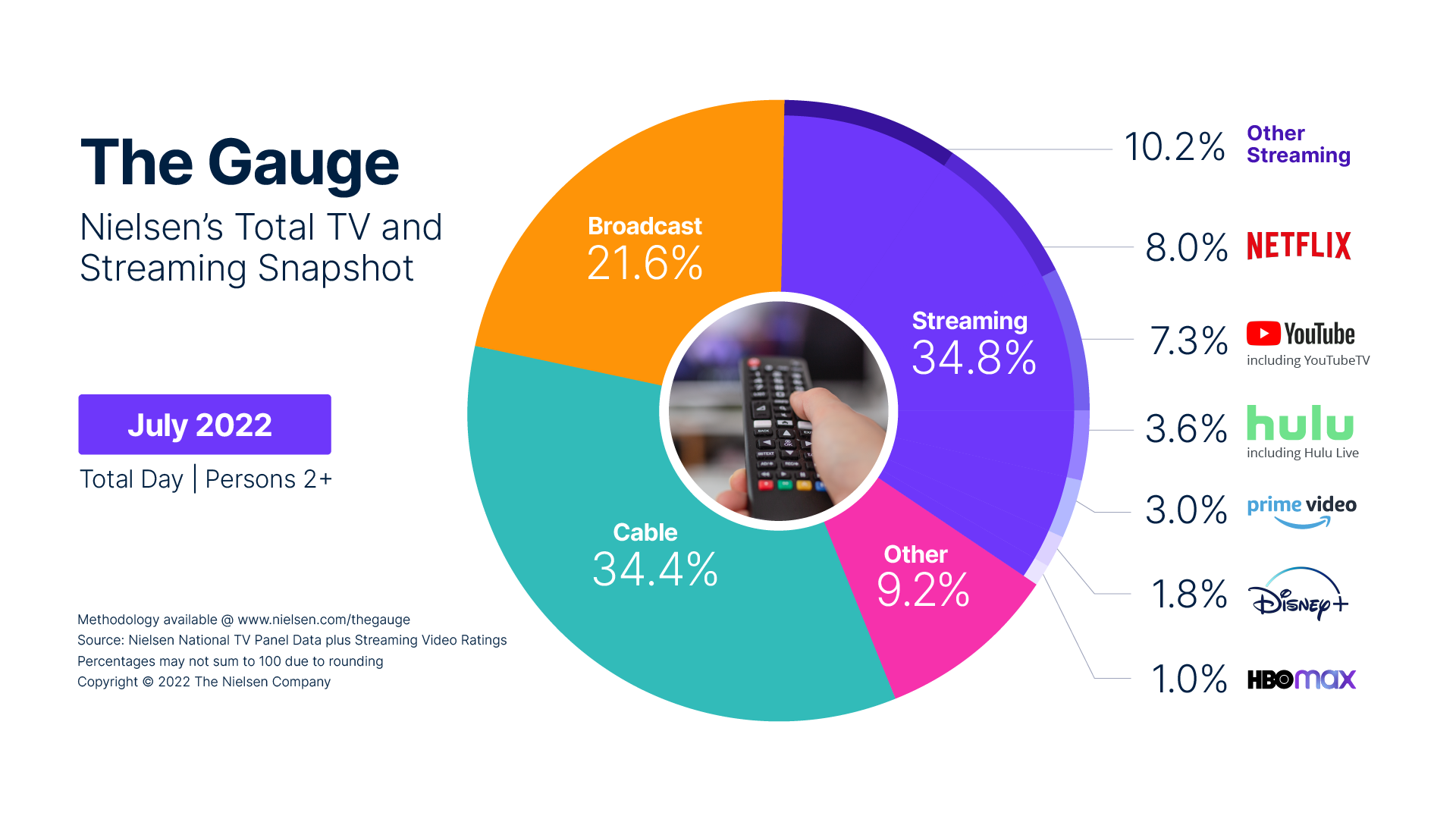Nielsen Notices That Streaming Has Surpassed Cable Viewing ... and Other Silly Season News (Bloom)
There’s plenty of reason for skepticism about Nielsen’s cross-platform measurement schemes. For starters, was this really the first time streaming has surpassed linear pay TV?

August can be silly season for news outlets, whether it’s the dog days of baseball season, D.C. politics, or the entertainment industry. WIth everyone off on vacation, less meaningful news tends to erupt, so outlets have to make do with smaller stories, which sometimes take on an unexpectedly substantial life.
Take, for example, headlines this past week that said something like “Streaming Surpasses Linear Viewing For First Time.” Well, yes and no.
Yes, Nielsen reported that subscription and “other” streaming services collectively topped “cable” in total day audience for the first time. It wasn’t much of a win, 34.8% for streaming to 34.4% for cable and 21.6% for broadcast (the “other” category took up the balance).

It’s definitely another data point in the industry’s complicated embrace of direct-to-consumer streaming as they move beyond their fading legacy platforms. And the “first” call was made by Nielsen, for goodness sake, which spent decades as the only metrics company that mattered in cable and broadcast.
That’s no longer the case, even in Legacy Land, where companies such as iSpot.TV now are creating “alternative currencies” measuring NBCUniversal programming.
Also read: Who's No. 1 in Subscription Streaming? Muddled Metrics Methodologies Make Matters Murky
And there’s plenty of reason for skepticism about Nielsen’s “The Gauge,” which attempts to measure viewing of everything related to “TV” as it exists everywhere. So, its own measurement, this is the first time streaming services have commanded a plurality of viewership, even if only barely. In survey speak, they call it within the margin of error.
NEXT TV NEWSLETTER
The smarter way to stay on top of the streaming and OTT industry. Sign up below.
Thing is, if you include the gazillion ways “TV” is watched, vast audiences have been watching shows on their mobile phones, tablets, computers, game machines and other devices for a long time. (Notable: For its weekly "top 10" rankings of subscription streaming, Nielsen uses data from its SVOD Content Ratings panel of 41,000 homes, which is "glass only" and does not include usage on mobile devices and computers. Nielsen does measure cross-platform viewing in other products.)
It’s worth noting The Gauge includes YouTube and Alphabet’s vMVPD YouTube TV in streaming (with 7.3% of total watch time). Given the billions of hours of YouTube viewing, for years now, some skepticism is in order about this being the “first” time streaming exceeded viewing by everyone over the age of 2, and especially by people under the age of 24.
This landmark, therefore, likely happened a long time ago. It’s just that Nielsen finally noticed, and mentioned it, and also, it’s August and silly season.
That said, it’s another (if less newsworthy) data point on the transition to the future, with plenty of other indications of shifting viewing patterns.
In England, where viewing is complicated by the annual license fee required of all TV owners to finance the BBC, a new survey by UK regulator Ofcom suggests that young viewers are pretty well done with watching traditional TV, Fortune said. The survey found on average, viewers under 24 spend less than an hour a day there, down two-thirds from just a decade ago.
That’s a worrisome long-term signal for the Beeb or any other legacy network. On the upside, the survey did provide semi-good short-term news, too: Viewers over 65 spend nearly six hours a day watching traditional TV. Somehow, that’s actually slightly higher than a decade ago.
And live or national events, such as women’s soccer championships or the Queen’s latest anniversary for something or other, continue to attract big audiences on traditional TV that Netflix and other streaming services haven’t quite matched.
Of course, none of this guarantees that subscription video on demand, specifically, is the future of "TV.” Lots of companies are experimenting with approaches that use both new and old platforms to build some new version of success.
My colleague Alan Wolk writes about the many people starting to notice that there actually were some things people liked about traditional cable TV, as long as you overlook “the bad interfaces, exploitative billing practices and horrible customer service.” Reminds of the joke, “Other than that, Mrs. Lincoln, how was the Ford Theater last night?”
But big bits of the legacy experience are finding analogs in the digital era, especially with the linear ad-supported services platform after platform is offering up.
Ease of access to a wide array of channels, a straightforward if limited interface, and even the simplicity of a single bill (however fast it kept going up, and however festooned it was with mystery charges).
I’m definitely feeling what Alan is saying, having just navigated, again, the ridiculous triple log-in system Disney requires of subscribers to its three-in-one streaming bundle, especially those trying to watch on their PC from their cabin instead of their main house. He compared cable interfaces to Stasi torture devices; some things are eternal, it would appear.
That said, blending old and new is definitely what David Zaslav is trying to do as he vivisects big hunks of HBO Max, pivots away from streaming exclusives, and decommissions low-visibility shows that cost more to stream than shelve. Instead, Warner Bros. Discovery will use Sony’s “arms dealer” approach and go back to selling “non-core” shows to others, while desperately hoping the theatrical exhibition business isn’t dying as fast as it seems to be.
He’s not alone in rediscovering the potentially good things about the past. As Bill Rouhana, chairman and CEO of Chicken Soup for the Soul, told me about his company’s plans to leverage old-school assets of its recent Red Box Entertainment acquisition, CSSE wouldn’t be “the first company to use a legacy business to finance a new-age business,” in his case, an AVOD-focused streaming company.
That said, Rouhana isn’t a fan of the FAST channels that have popped up in profusion in recent months as media companies desperately try to monetize their increasingly ignored library content on streaming. On-demand streaming services still have a lot of work to do on their recommendation and search engines, he said, to make sure people routinely and easily get shows they want to watch.
Meanwhile, other companies are trying to teach old dogs new tricks, such as Boise-based Evoca, which combines online connectivity and the ATSC 3.0 Next-Gen broadcast TV standard to deliver local programming, regional sports networks, and an option to get Sling TV’s low-cost virtual MVPD service as well.
The approach provides interactivity, access to the highest-quality video streams, and a scalable infrastructure that costs the company about the same whether it’s reaching 100 subscribers or 100,000. Evoca is now in seven markets in five states.
“I think innovation is key to the future of broadcast, and I think the future of broadcast is incredibly bright,” Evoca CEO Todd Achilles told me. “The new technology opens up new business models and that's what we're experimenting with.”
Achilles is even a big fan of one of the seemingly most endangered of legacy offerings, the regional sports network. He saw what happened when the company offered Altitude Sports to the many, many local fans of Denver sports franchises who couldn’t get the service because it couldn’t get room on many MVPDs’ cable boxes.
All of which is to say, streaming has probably been No. 1 in various ways for a while. And Nielsen is going to have to keep opening up The Gauge to measure all of the many, many ways people are now using to get their fix of “TV.”
This story was updated to clarify Nielsen's methodology for measuring cross-platform viewing.
David Bloom of Words & Deeds Media is a Santa Monica, Calif.-based writer, podcaster, and consultant focused on the transformative collision of technology, media and entertainment. Bloom is a senior contributor to numerous publications, and producer/host of the Bloom in Tech podcast. He has taught digital media at USC School of Cinematic Arts, and guest lectures regularly at numerous other universities. Bloom formerly worked for Variety, Deadline, Red Herring, and the Los Angeles Daily News, among other publications; was VP of corporate communications at MGM; and was associate dean and chief communications officer at the USC Marshall School of Business. Bloom graduated with honors from the University of Missouri School of Journalism.

